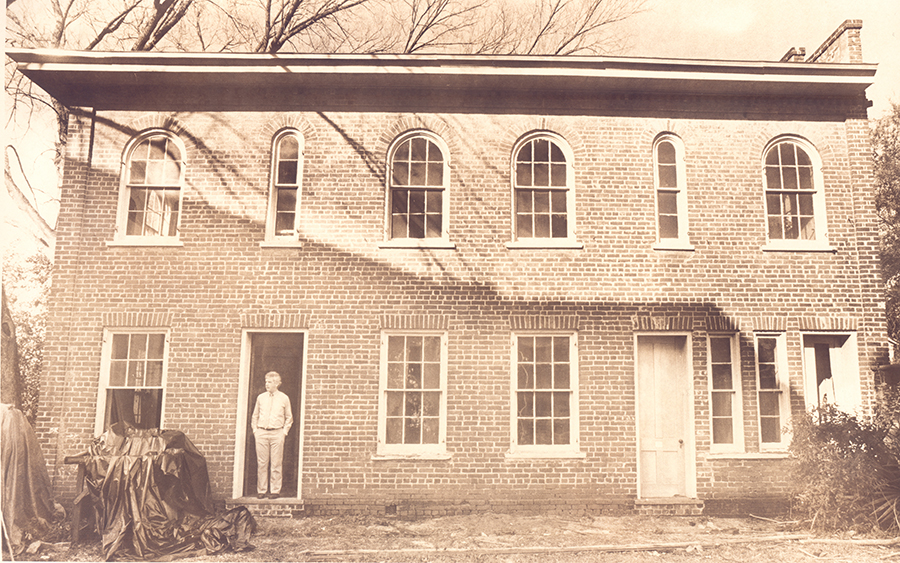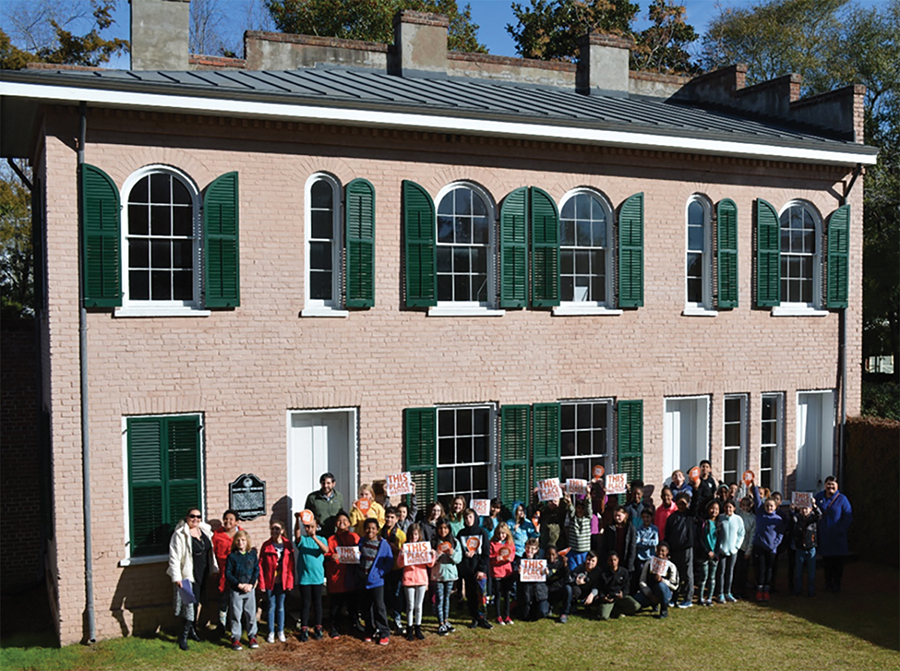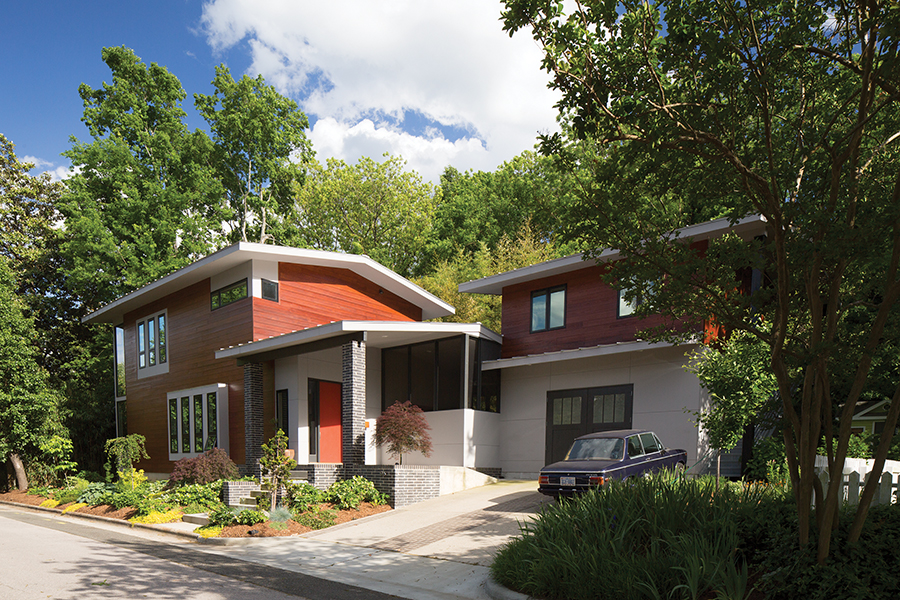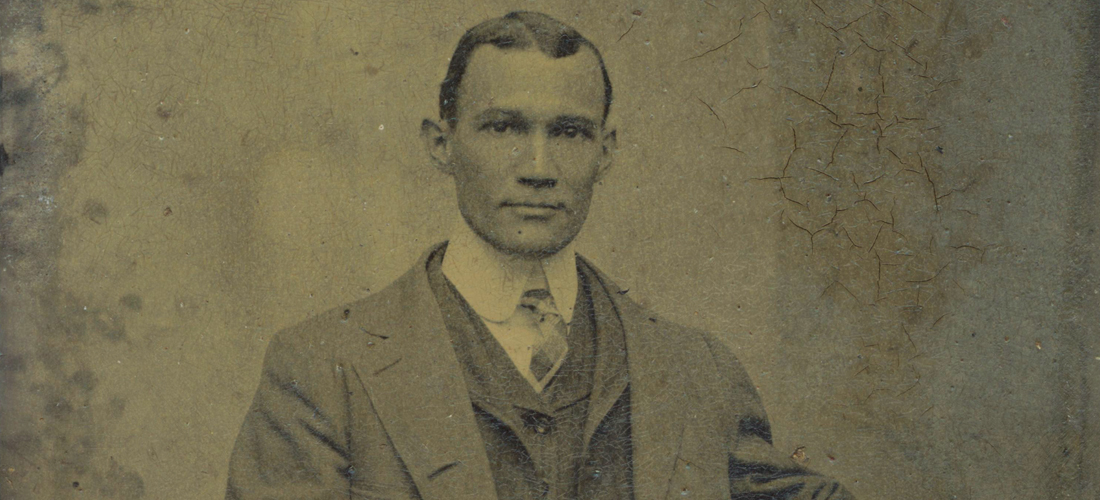Rewriting History
Myrick Howard and Preservation North Carolina deliver new life to old buildings
By J. Michael Welton
For more than 40 years, Myrick Howard has dedicated his life to the preservation of North Carolina’s architectural heritage.
It’s an exceptional cultural contribution to the state, matched probably only by curator and historian Catherine Bishir, the author of North Carolina Architecture, her encyclopedic catalog of design. Between the two of them, Howard and Bishir have created an elevated atmosphere for appreciating the role architecture plays in the lives of all North Carolinians.


Howard has done that by placing himself squarely on the front lines of historic preservation. He prepped himself for his career by attending UNC-Chapel Hill, with a double major in law and urban planning. When he graduated in 1978, he headed straight for the organization now known as Preservation North Carolina. “I took a part-time job first, and within another month or so, I was executive director,” the Durham native says.
It’s the only job he’s ever had. When he arrived, PNC was a one-person shop in Raleigh. Today it stretches across the state, with 12 full-time employees in offices in Raleigh, Greenville, Durham and Shelby, and a number of part-time employees in Wilmington.
All the while, PNC has earned consistently high marks on the national stage. “Preservation North Carolina is the envy of the country,” says Raleigh architect Frank Harmon. “Even Virginia doesn’t have anything like it. He’s extraordinary.”
Howard is also modest as he goes about the business of saving our historic buildings. “It’s a matter of principle that the organization is not about him, but about the preservation of North Carolina,” Harmon says. “There’s this incredibly valuable history of his work, and this very creative genius about it.”
His background in law provides dual benefits. Clearly it’s influenced his organizational abilities. But it also informs his contention that preservation is mostly about real estate. “Not a day goes by without my looking at a contract,” says Howard. “It’s a way to get to the point — a way of thinking, where you get rid of the extraneous thoughts.”

PNC — he calls the organization an “animal shelter for historic buildings” — favors action over talk. “We try to find people to take over these buildings,” says Howard. “We’ve done over 800 with direct connections, and there are hundreds of others that we’ve helped out over the years.”
Howard was instrumental in developing PNC’s formula for success. He inherited a revolving fund for the acquisition of properties from an earlier organization, then expanded its use. He matches up potential owners or developers with projects, and motivates them with the application of state and federal historic tax credits. Uses of the renovated buildings often create jobs, while enhancing tax bases with historic properties used in new ways.
It’s a process that requires vision, patience and expertise in connecting the dots of who should be involved with each project. “His mental Rolodex is very deep,” says landscape architect Rodney Swink, a senior associate at PlaceEconomics who’s known Howard for more than 30 years. “And he has the ability to suggest a number of possibilities for a building.”
“He’s an innovative leader on how to get preservation done,” says Ellen Turco, chair of the Wake Forest Historic Preservation Commission. “The old model was to create a nonprofit to save buildings, raise money locally and turn the building into a museum. But every building with value can’t be a museum — so how can it be a hotel, a restaurant or a living space?”
Turco cites a number of projects Howard’s been involved with, both big and small. “There’s Loray Mill in Gastonia — it’s the largest in the state and the South,” she says. “And he’s just as impactful in smaller communities as larger ones — there’s Proximity Mill in Greensboro, Edenton Cotton Mill, and Rocky Mount Mills.”
The one structure that Howard and PNC did save and convert into a museum is the antebellum Bellamy Mansion in Wilmington. And for good reason: The building is a one-of-a-kind symbol of North Carolina’s rich, diverse and volatile history — and a centerpiece in historic downtown Wilmington.
“Of all the buildings PNC has done, it’s the only one they kept,” says Gareth Evans, executive director of the Bellamy Mansion Museum of Historic Design and Art. “They call it a stewardship property: They didn’t revolve it through, but remained its owners and managers.”
What’s significant about the Bellamy is that it delves deep into social issues. Built during the Civil War in what was then North Carolina’s largest and wealthiest city — Wilmington was a thriving port, after all — Bellamy was a town home for a plantation-owning family, with slave quarters on-site.
Wilmington-based architects designed it, and slaves and freedmen built it, which broadens its appeal to a wide base of visitors. “It connects people to history and the community,” Howard says. “It’s a huge asset — 30,000 people go through it every year, and there’s programming of significance. It’s inclusive and tells the full story of the site of the (1898) Wilmington Race Riot. It was talking about that well before it was comfortable to do that. It talks bluntly about slavery and what it meant.”
After the Civil War, the mansion became home to the Freedmen’s Bureau, while Wilmington’s thriving black middle class began to grow and prosper. In 1896, the United States Supreme Court ruling in Plessey versus Ferguson validated the concept of “separate but equal.” It was a step that encouraged the establishment of Jim Crow — and much more.
On Nov. 10, 1898, in Wilmington, an angry mob of about 500 whites marched on the African-American Daily Record, burned its building and destroyed its presses. They roamed the city, terrifying black neighborhoods as their inhabitants fled. Much of the action took place within two blocks of the Bellamy.
For the next three-quarters of a century, whites ruled not just the local government in Wilmington, but most of the South. “The Wilmington Race Riot basically set it up, and white power took over,” says Howard. “The message was that you can close down voting and kick out African-American officeholders and nobody will tell you otherwise.”
The day before the 1898 riot, owner John D. Bellamy had gone to Congress to retrieve his family home from the Freedmen’s Bureau. He succeeded, and his descendants would live in the home until the late 1940s. In 1993, PNC took title to the Greek Revival house and initiated its restoration, following up on the former slave quarters in the 2010s.
Howard calls the Bellamy a major success, with PNC raising more than $2 million for it, excluding operating funds. Beyond renovation, they’ve made overt efforts toward mending social fences. “We tried with Bellamy to do things to get both whites and people of color into the same place to communicate and to get to know each other,” Howard says. “There was an opportunity to do that with the full restoration of the slave quarters. We did this early on, and it’s an important part of what we do.”
He’s quick to give credit to the Historic Wilmington Foundation for their early preservation efforts before PNC arrived there, though there’s still much left to do. “There are neighborhoods there that could use more investment, with a substantial African-American community there,” he says.
In Raleigh’s historic Oakwood neighborhood in 2014, Howard publicly exercised his judgment and influence in different ways. As he did, he helped define the evolving nature of 21st century historic preservation.
It was a situation steeped in controversy. Architect Louis Cherry and his wife, N.C. State film professor Marsha Gordon, had designed and begun to build an updated, Craftsman-style home on a small Oakwood lot. A neighbor across the street questioned its appropriateness for a community full of 19th and 20th century residences.
And she did it in the most public of ways, appealing the Raleigh Historic Development District’s approval of the design to the city’s Board of Adjustments, which overturned the RHDD’s decision. That launched a three-year public imbroglio.
“The opposition was saying this ‘modern’ house was destroying the neighborhood — with cold and cruel and weird rhetoric,” says Gordon. “They were using ‘modern’ as a bad word to characterize an architectural style.”
The neighbor met with some success, managing to have the half-finished home’s construction permits revoked and threatening it with demolition. “The opposition said it threatened the historic nature of the neighborhood, and that it would lose its historic district status and designation,” says Gordon.
Howard would write Oakwood residents a letter with his thoughts on historic architecture and modernism, on Feb. 22, 2014:
“I believe that the design of the Cherry/Gordon home is in line with a half-century of preservation philosophy and practice, contrary to the assertions of their opponents,” he wrote.
“Most of Raleigh’s historic districts were built over a period of decades — house-by-house, owner-by-owner. Thus, unlike modern subdivisions, they contain numerous styles and sizes, and it is this richness that gives them their character. They are mosaics, made up of many distinctive parts. No one style predominates, so it is not useful to prescribe stylistic limitations.”
On Aug. 28, he wrote to The News & Observer in Raleigh:
“If we look up the characteristics of modernist style, the new Oakwood house really isn’t modernist. Yes, it’s ‘modern.’ It’s ‘contemporary.’ But ‘modernist’? No. The house is more akin to buildings built in the early to mid 20th century than it is to ‘modernism.’ That helps make it fit into the historic district.”
Howard had modulated the controversy for public consumption. “He was using the crisis as a teaching moment for a well-accepted way that historic preservation was understood by the National Park Service, the current best thinking in the historic preservation community,” says Cherry. “The result was wide public pressure on the city to join with us in our legal situation. He was absolutely critical in our defense.”
In February 2016, the North Carolina Court of Appeals found that the neighbor had no legal standing, and ruled in favor of Cherry and Gordon. In March, their neighbor appealed to the state Supreme Court, which declined to rule on the case in August. Cherry and Gordon live happily in their home today, thanks in part to Howard.
Ask Howard about his most important achievement at PNC, and he’s quick to bring up the topic of state historic tax credits, which have been used on more than $2 billion in property. PNC established them first in 1993, reinstated them in 1997 and later expanded them from residences to industrial and utility buildings. “That’s how all these mills are being renovated,” he says. “We were the ones who testified and wrote the original language. They’ve gone way beyond what we remotely imagined when we got this started.”
When the General Assembly abolished them in 2015, Howard initiated a plan to reinstate them in 2016 — and succeeded. “Myrick has had to re-educate a whole new group over and over, that they’re not only to benefit the wealthy, but have had as big an impact on small and middle-size businesses as anything the legislature has ever done,” says Steve Schuster, principal in Raleigh’s Clearscapes. “The economic development they spur has a profound impact across the state.”
The underlying lesson of historic tax credits is that they’re not just about preserving old or historic buildings — though certainly they achieve that — but that they’re effective economic development tools for big cities and small towns alike. And Howard is their most effective advocate at the legislature. “He’s been willing to plow that same field repeatedly,” says Schuster.
The harvest has benefited every region of North Carolina, from the mountains to the ocean. “A lot of buildings are still there, because of his leadership,” says Catherine Bishir. “An awful lot of buildings and even communities were rescued, and without PNC, I don’t think would have happened.”
There are more to come. “There are plenty of projects I’m in the middle of right now,” says Howard. “I enjoy the work, and I plan to stick around a while longer.”
That’s something sure to accrue to the benefit of every North Carolinian who cares about history, architecture — and healthy local economies.
Preservation North Carolina’s annual conference will be held from October 17- 19 in Wrightsville Beach, offering a variety of educational sessions, tours, and special events. Open to all interested in old houses and preservation. For more information, visit presnc.org.
J. Michael Welton writes about architecture, art and design for national and international publications, and edits a digital design magazine at www.architectsandartisans.com. He is the author of Drawing from Practice: Architects and the Meaning of Freehand (Routledge: 2015). He can be reached at [email protected].


